tow CITROEN AMI 2021 Handbook (in English)
[x] Cancel search | Manufacturer: CITROEN, Model Year: 2021, Model line: AMI, Model: CITROEN AMI 2021Pages: 44, PDF Size: 1.67 MB
Page 4 of 44
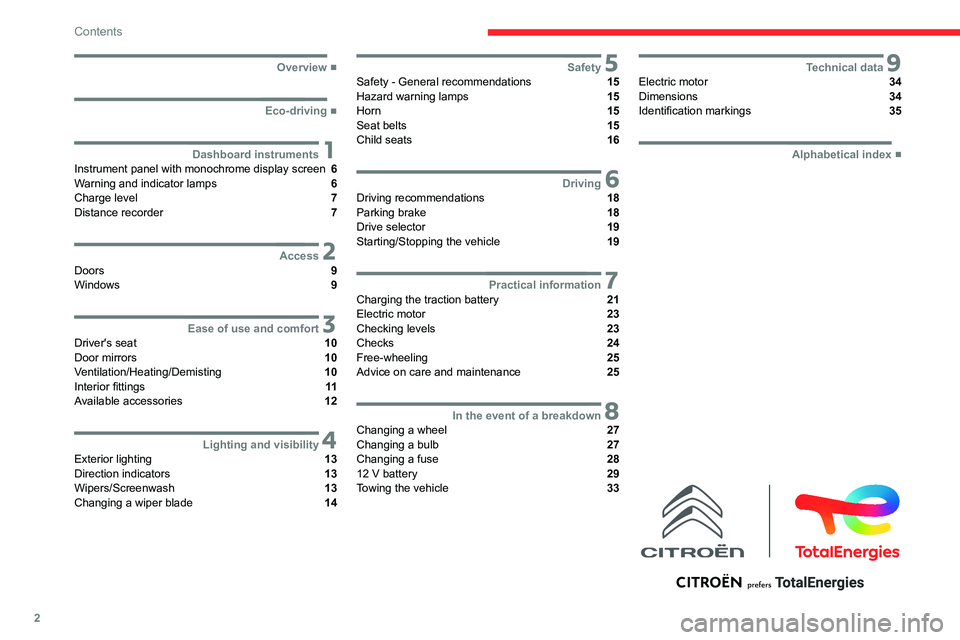
2
Contents
■
Overview
■
Eco-driving
1Dashboard instrumentsInstrument panel with monochrome display screen 6
Warning and indicator lamps 6
Charge level 7
Distance recorder 7
2AccessDoors 9
Windows 9
3Ease of use and comfortDriver's seat 10
Door mirrors 10
Ventilation/Heating/Demisting 10
Interior fittings 11
Available accessories 12
4Lighting and visibilityExterior lighting 13
Direction indicators 13
Wipers/Screenwash 13
Changing a wiper blade 14
5SafetySafety - General recommendations 15
Hazard warning lamps 15
Horn 15
Seat belts 15
Child seats 16
6DrivingDriving recommendations 18
Parking brake 18
Drive selector 19
Starting/Stopping the vehicle 19
7Practical informationCharging the traction battery 21
Electric motor 23
Checking levels 23
Checks 24
Free-wheeling 25
Advice on care and maintenance 25
8In the event of a breakdownChanging a wheel 27
Changing a bulb 27
Changing a fuse 28
12 V battery 29
Towing the vehicle 33
9Technical dataElectric motor 34
Dimensions 34
Identification markings 35
■
Alphabetical index
Page 6 of 44
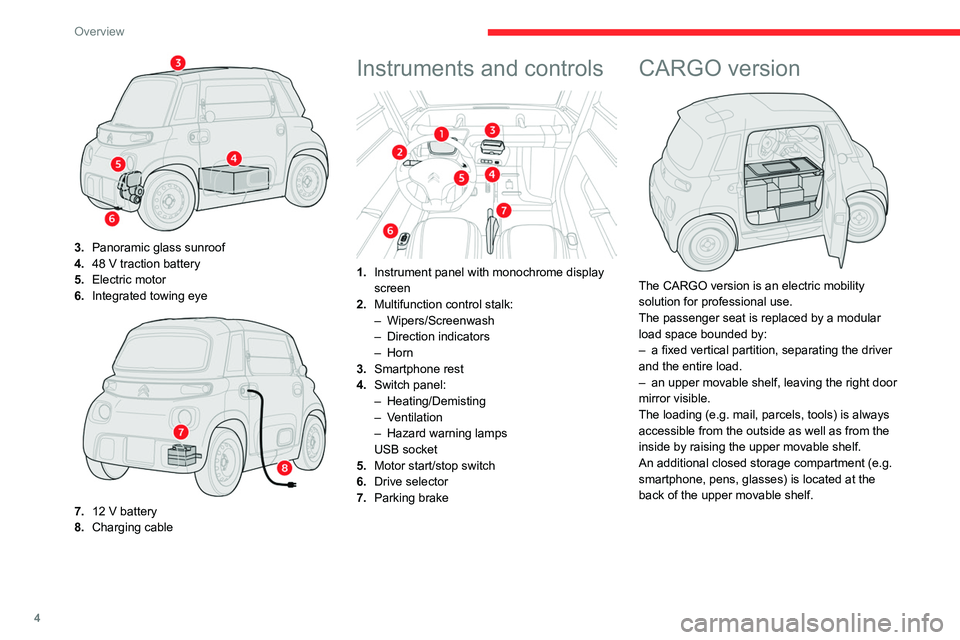
4
Overview
3.Panoramic glass sunroof
4. 48 V traction battery
5. Electric motor
6. Integrated towing eye
7.12 V battery
8. Charging cable
Instruments and controls
1.Instrument panel with monochrome display
screen
2. Multifunction control stalk:
–
Wipers/Screenwash
– Direction indicators
– Horn
3. Smartphone rest
4. Switch panel:
–
Heating/Demisting
– V
entilation
–
Hazard warning lamps
USB socket
5. Motor start/stop switch
6. Drive selector
7. Parking brake
CARGO version
The CARGO version is an electric mobility
solution for professional use.
The passenger seat is replaced by a modular
load space bounded by:
–
a fixed vertical partition, separating the driver
and the entire load.
–
an upper movable shelf, leaving the right door
mirror visible.
The loading (e.g. mail, parcels, tools) is always
accessible from the outside as well as from the
inside by raising the upper movable shelf.
An additional closed storage compartment (e.g.
smartphone, pens, glasses) is located at the
back of the upper movable shelf.
Page 14 of 44
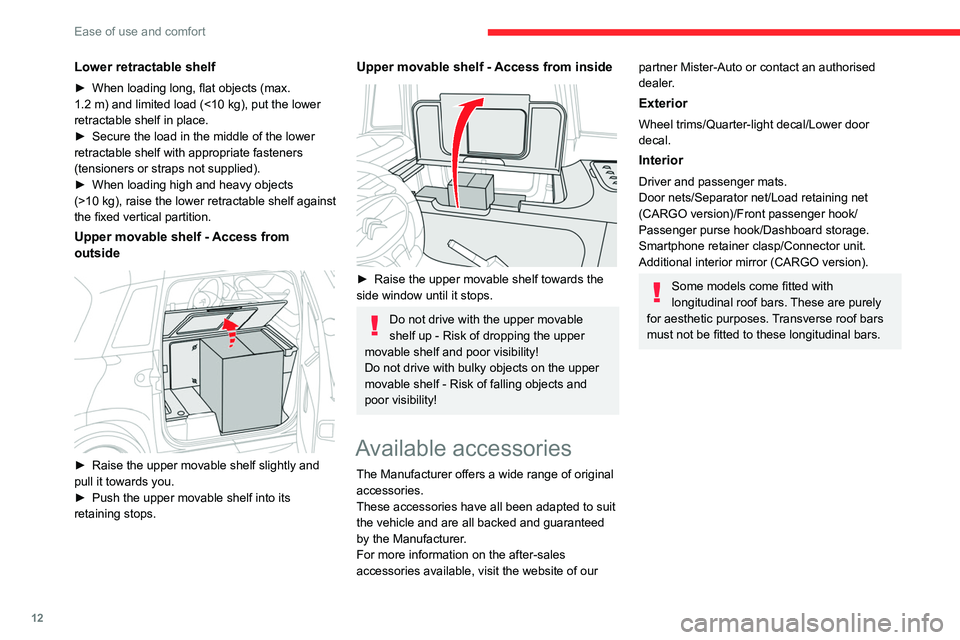
12
Ease of use and comfort
Lower retractable shelf
► When loading long, flat objects (max.
1.2 m) and limited load (<10 kg), put the lower
retractable shelf in place.
►
Secure the load in the middle of the lower
retractable shelf with appropriate fasteners
(tensioners or straps not supplied).
►
When loading high and heavy objects
(>10 kg), raise the lower retractable shelf against
the fixed vertical partition.
Upper movable shelf - Access from
outside
► Raise the upper movable shelf slightly and
pull it towards you.
►
Push the upper movable shelf into its
retaining stops.
Upper movable shelf - Access from inside
► Raise the upper movable shelf towards the
side window until it stops.
Do not drive with the upper movable
shelf up - Risk of dropping the upper
movable shelf and poor visibility!
Do not drive with bulky objects on the upper
movable shelf
- Risk of falling objects and
poor visibility!
Available accessories
The Manufacturer offers a wide range of original
accessories.
These accessories have all been adapted to suit
the vehicle and are all backed and guaranteed
by the Manufacturer.
For more information on the after-sales
accessories available, visit the website of our
partner Mister-Auto or contact an authorised
dealer.
Exterior
Wheel trims/Quarter-light decal/Lower door
decal.
Interior
Driver and passenger mats.
Door nets/Separator net/Load retaining net
(CARGO version)/Front passenger hook/
Passenger purse hook/Dashboard storage.
Smartphone retainer clasp/Connector unit.
Additional interior mirror (CARGO version).
Some models come fitted with
longitudinal roof bars. These are purely
for aesthetic purposes. Transverse roof bars
must not be fitted to these longitudinal bars.
Page 15 of 44
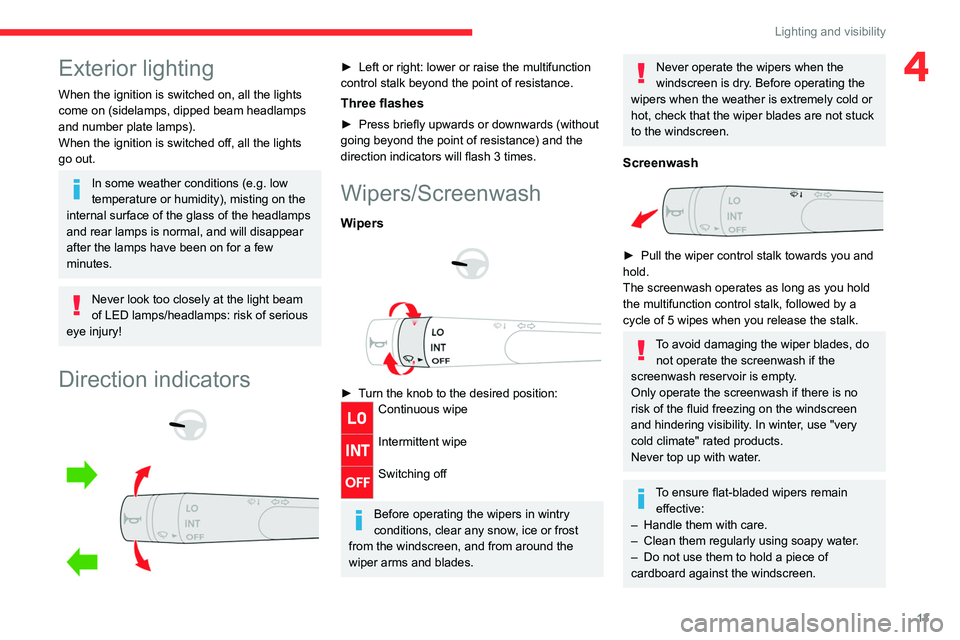
13
Lighting and visibility
4Exterior lighting
When the ignition is switched on, all the lights
come on (sidelamps, dipped beam headlamps
and number plate lamps).
When the ignition is switched off, all the lights
go out.
In some weather conditions (e.g. low
temperature or humidity), misting on the
internal surface of the glass of the headlamps
and rear lamps is normal, and will disappear
after the lamps have been on for a few
minutes.
Never look too closely at the light beam
of LED lamps/headlamps: risk of serious
eye injury!
Direction indicators
► Left or right: lower or raise the multifunction
control stalk beyond the point of resistance.
Three flashes
► Press briefly upwards or downwards (without
going beyond the point of resistance) and the
direction indicators will flash 3 times.
Wipers/Screenwash
Wipers
► Turn the knob to the desired position:Continuous wipe
Intermittent wipe
Switching off
Before operating the wipers in wintry
conditions, clear any snow, ice or frost
from the windscreen, and from around the
wiper arms and blades.
Never operate the wipers when the
windscreen is dry. Before operating the
wipers when the weather is extremely cold or
hot, check that the wiper blades are not stuck
to the windscreen.
Screenwash
► Pull the wiper control stalk towards you and
hold.
The screenwash operates as long as you hold
the multifunction control stalk, followed by a
cycle of 5 wipes when you release the stalk.
To avoid damaging the wiper blades, do not operate the screenwash if the
screenwash reservoir is empty.
Only operate the screenwash if there is no
risk of the fluid freezing on the windscreen
and hindering visibility. In winter, use "very
cold climate" rated products.
Never top up with water.
To ensure flat-bladed wipers remain effective:
–
Handle them with care.
– Clean them regularly using soapy water.
– Do not use them to hold a piece of
cardboard against the windscreen.
Page 16 of 44
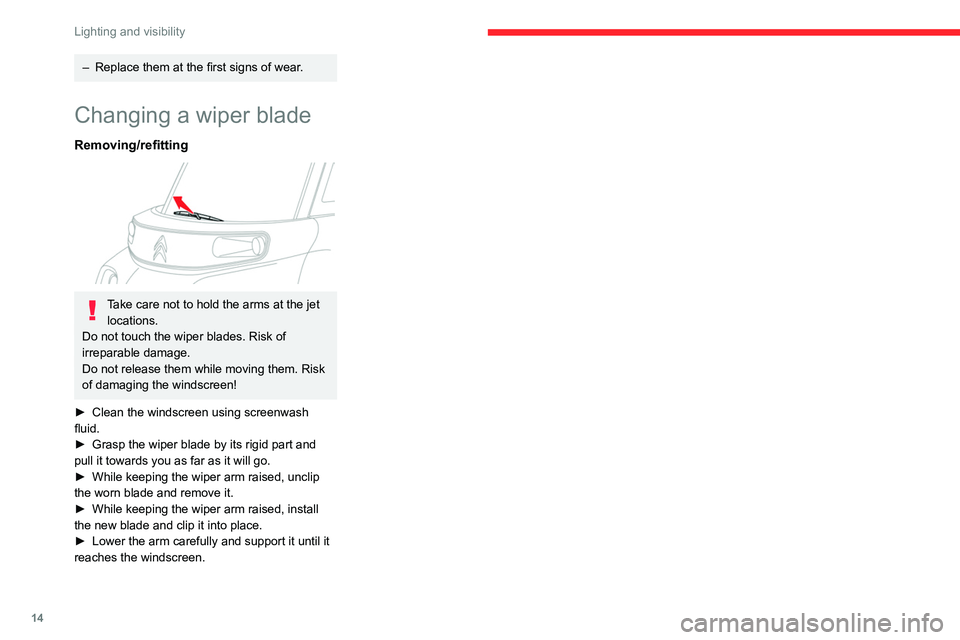
14
Lighting and visibility
– Replace them at the first signs of wear.
Changing a wiper blade
Removing/refitting
Take care not to hold the arms at the jet locations.
Do not touch the wiper blades. Risk of
irreparable damage.
Do not release them while moving them. Risk
of damaging the windscreen!
►
Clean the windscreen using screenwash
fluid.
►
Grasp the wiper blade by its rigid part and
pull it towards you as far as it will go.
►
While keeping the wiper arm raised, unclip
the worn blade and remove it.
►
While keeping the wiper arm raised, install
the new blade and clip it into place.
►
Lower the arm carefully and support it until it
reaches the windscreen.
Page 22 of 44
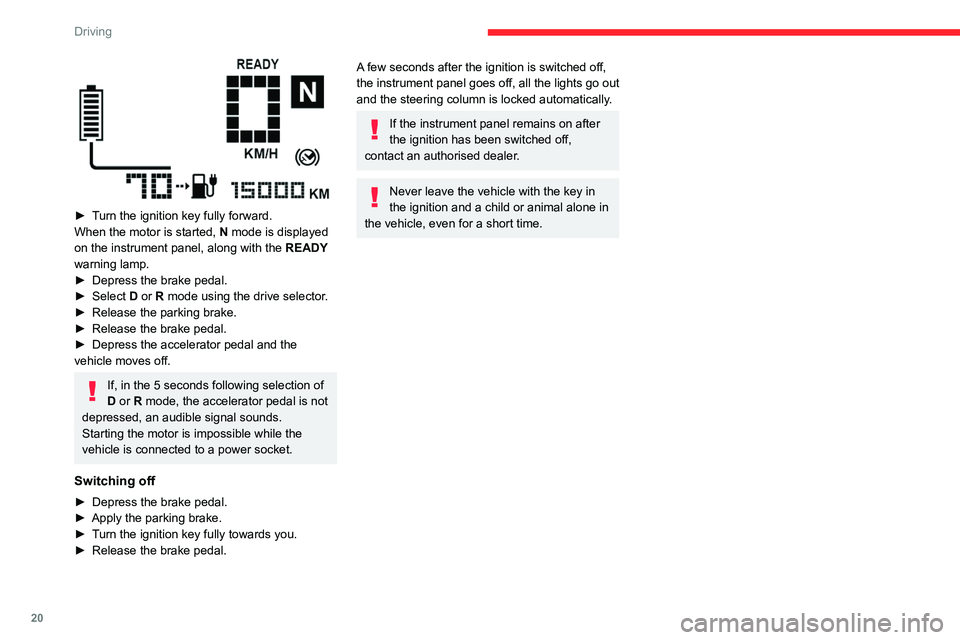
20
Driving
► Turn the ignition key fully forward.
When the motor is started, N mode is displayed
on the instrument panel, along with the READY
warning lamp.
►
Depress the brake pedal.
► Select D
or R mode using the drive selector.
►
Release the parking brake.
► Release the brake pedal.
► Depress the accelerator pedal and the
vehicle moves off.
If, in the 5 seconds following selection of
D or R mode, the accelerator pedal is not
depressed, an audible signal sounds.
Starting the motor is impossible while the
vehicle is connected to a power socket.
Switching off
► Depress the brake pedal.
► Apply the parking brake.
► Turn the ignition key fully towards you.
► Release the brake pedal.
A few seconds after the ignition is switched off,
the instrument panel goes off, all the lights go out
and the steering column is locked automatically.
If the instrument panel remains on after
the ignition has been switched off,
contact an authorised dealer.
Never leave the vehicle with the key in
the ignition and a child or animal alone in
the vehicle, even for a short time.
Page 26 of 44
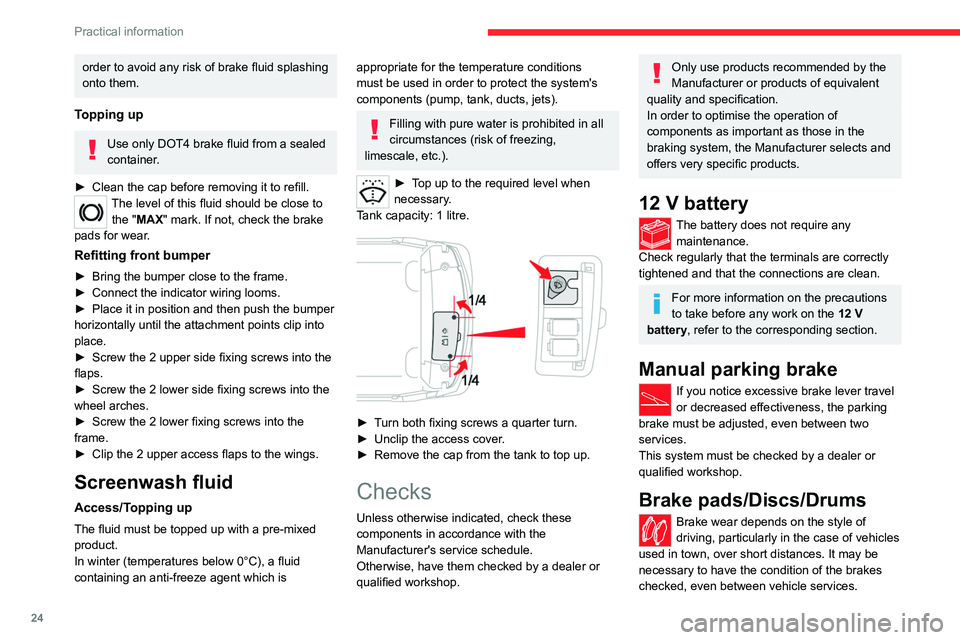
24
Practical information
order to avoid any risk of brake fluid splashing
onto them.
Topping up
Use only DOT4 brake fluid from a sealed
container.
►
Clean the cap before removing it to refill.The level of this fluid should be close to the "MAX" mark. If not, check the brake
pads for wear.
Refitting front bumper
► Bring the bumper close to the frame.
► Connect the indicator wiring looms.
► Place it in position and then push the bumper
horizontally until the attachment points clip into
place.
►
Screw the 2 upper side fixing screws into the
flaps.
►
Screw the 2 lower side fixing screws into the
wheel arches.
►
Screw the 2 lower fixing screws into the
frame.
►
Clip the 2 upper access flaps to the wings.
Screenwash fluid
Access/Topping up
The fluid must be topped up with a pre-mixed
product.
In winter (temperatures below 0°C), a fluid
containing an anti-freeze agent which is
appropriate for the temperature conditions
must be used in order to protect the system's
components (pump, tank, ducts, jets).
Filling with pure water is prohibited in all
circumstances (risk of freezing,
limescale, etc.).
► Top up to the required level when
necessary .
Tank capacity: 1 litre.
► Turn both fixing screws a quarter turn.
► Unclip the access cover.
► Remove the cap from the tank to top up.
Checks
Unless otherwise indicated, check these
components in accordance with the
Manufacturer's service schedule.
Otherwise, have them checked by a dealer or
qualified workshop.
Only use products recommended by the
Manufacturer or products of equivalent
quality and specification.
In order to optimise the operation of
components as important as those in the
braking system, the Manufacturer selects and
offers very specific products.
12 V battery
The battery does not require any maintenance.
Check regularly that the terminals are correctly
tightened and that the connections are clean.
For more information on the precautions
to take before any work on the 12 V
battery
, refer to the corresponding section.
Manual parking brake
If you notice excessive brake lever travel
or decreased effectiveness, the parking
brake must be adjusted, even between two
services.
This system must be checked by a dealer or
qualified workshop.
Brake pads/Discs/Drums
Brake wear depends on the style of
driving, particularly in the case of vehicles
used in town, over short distances. It may be
necessary to have the condition of the brakes
checked, even between vehicle services.
Page 27 of 44
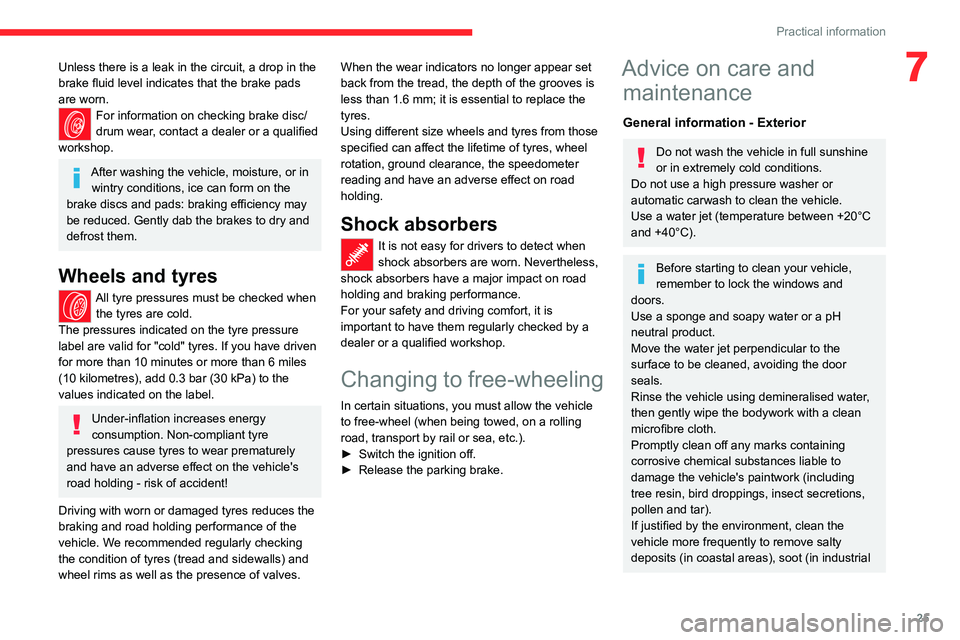
25
Practical information
7Unless there is a leak in the circuit, a drop in the
brake fluid level indicates that the brake pads
are worn.
For information on checking brake disc/
drum wear, contact a dealer or a qualified
workshop.
After washing the vehicle, moisture, or in wintry conditions, ice can form on the
brake discs and pads: braking efficiency may
be reduced. Gently dab the brakes to dry and
defrost them.
Wheels and tyres
All tyre pressures must be checked when the tyres are cold.
The pressures indicated on the tyre pressure
label are valid for "cold" tyres. If you have driven
for more than 10 minutes or more than 6 miles
(10 kilometres), add 0.3 bar (30 kPa) to the
values indicated on the label.
Under-inflation increases energy
consumption. Non-compliant tyre
pressures cause tyres to wear prematurely
and have an adverse effect on the vehicle's
road holding - risk of accident!
Driving with worn or damaged tyres reduces the
braking and road holding performance of the
vehicle. We recommended regularly checking
the condition of tyres (tread and sidewalls) and
wheel rims as well as the presence of valves. When the wear indicators no longer appear set
back from the tread, the depth of the grooves is
less than 1.6 mm; it is essential to replace the
tyres.
Using different size wheels and tyres from those
specified can affect the lifetime of tyres, wheel
rotation, ground clearance, the speedometer
reading and have an adverse effect on road
holding.
Shock absorbers
It is not easy for drivers to detect when
shock absorbers are worn. Nevertheless,
shock absorbers have a major impact on road
holding and braking performance.
For your safety and driving comfort, it is
important to have them regularly checked by a
dealer or a qualified workshop.
Changing to free-wheeling
In certain situations, you must allow the vehicle
to free-wheel (when being towed, on a rolling
road, transport by rail or sea, etc.).
►
Switch the ignition off.
► Release the parking brake.
Advice on care and maintenance
General information - Exterior
Do not wash the vehicle in full sunshine
or in extremely cold conditions.
Do not use a high pressure washer or
automatic carwash to clean the vehicle.
Use a water jet (temperature between +20°C
and +40°C).
Before starting to clean your vehicle,
remember to lock the windows and
doors.
Use a sponge and soapy water or a pH
neutral product.
Move the water jet perpendicular to the
surface to be cleaned, avoiding the door
seals.
Rinse the vehicle using demineralised water,
then gently wipe the bodywork with a clean
microfibre cloth.
Promptly clean off any marks containing
corrosive chemical substances liable to
damage the vehicle's paintwork (including
tree resin, bird droppings, insect secretions,
pollen and tar).
If justified by the environment, clean the
vehicle more frequently to remove salty
deposits (in coastal areas), soot (in industrial
Page 29 of 44

27
In the event of a breakdown
8Changing a wheel
The vehicle is not equipped with on-board tools,
such as a jack or wheel brace.
In the event of a flat tyre, call a dealer or
qualified workshop.
To have winter tyres fitted or the wheels
changed, consult a dealer or qualified workshop.
Changing a bulb
Cleaning
The headlamps have polycarbonate
lenses with a protective coating:
–
Do not clean them with a dry or abrasive
cloth, nor with detergent or solvent
products.
–
Use a sponge and soapy water or a pH
neutral product.
–
When using a jet of water to clean off
persistent marks, do not keep the jet directed
towards the headlamps, lamps or their
edges for too long, so as not to damage their
protective coating and seals.
Light-emitting diodes (LEDs)
Do not touch LED headlamps/lamps.
To replace this type of bulb, you must consult
a dealer or qualified workshop.
Direction indicators
Rapid flashing of the indicator lamp for a
direction indicator
(left or right) indicates that
one of the bulbs on the corresponding side
has failed.
Front lamps
1. Direction indicators
2. Sidelamps
3. Dipped beam headlamps
Rear lamps
1.Direction indicators
2. Sidelamps
3. Brake lamps
4. Number plate lamp
Page 35 of 44

33
In the event of a breakdown
8Towing the vehicle
Observe the legislation in force in the
country where you are driving.
Before towing the vehicle, it is essential to put
the vehicle in free-wheeling mode.
For more information on Free-wheeling, refer
to the corresponding section.
An electric vehicle must never be used for road transfers.
It may be used, for example, to exit a rut.
Towing constraints
Front
wheels on the
ground Rear
wheels on the
ground Flatbed 4
wheels on the
ground with
towbar
Use the towing eye only to free the vehicle when
stuck, or to secure it for recovery on a flatbed
lorry or trailer.